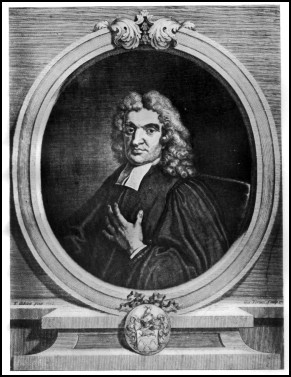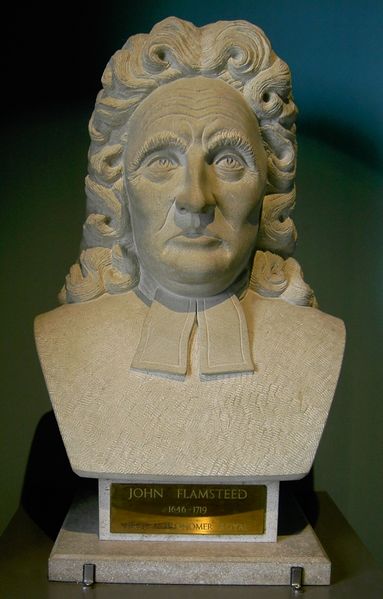<Back to Index>
- Astronomer John Flamsteed, 1646
- Painter Josef Danhauser, 1805
- President of Portugal José Mendes Cabeçadas, 1883
PAGE SPONSOR


John Flamsteed FRS (19 August 1646 – 31 December 1719) was an English astronomer and the first Astronomer Royal.
Flamsteed was born in Denby, Derbyshire, England, and was educated at Derby School, in St Peter's Churchyard, Derby, near where his father carried on a malting business. At that time, most masters of the school were Puritans. Flamsteed had a solid knowledge of Latin, essential for reading the literature of the day, and a love of history, leaving the school in May, 1662.
His progress to Jesus College, Cambridge, recommended by the Master of Derby School, was delayed by some years of chronic ill health. During those years, Flamsteed gave his father some help in his business, and from his father learnt arithmetic and the use of fractions, but he used those years also to develop a keen interest in mathematics and astronomy. In July 1662, he was fascinated by the thirteenth century work of Johannes de Sacrobosco, De sphaera mundi, and on 12 September 1662 observed his first partial solar eclipse. Early in 1663, he read Thomas Fale's The Art of Dialling, which set off an interest in sundials. In the summer of 1663, he read Wingate's Canon, William Oughtred's Canon, and Thomas Stirrup's Art of Dialling. At about the same time, he acquired Thomas Street's Astronomia Carolina, or A New Theory of the Celestial Motions (Caroline Tables). He associated himself with local gentlemen interested in astronomy, including William Litchford, whose library included the work of the astrologer John Gadbury which included astronomical tables by Jeremiah Horrocks, who had died in 1641 at the age of twenty-three. Flamsteed was greatly impressed (as Isaac Newton had been) by the work of Horrocks.
In August 1665, at the age of nineteen and as a gift for his friend Litchford, Flamsteed wrote his first paper on astronomy, entitled Mathematical Essays, concerning the design, use and construction of an astronomer's quadrant, including tables for the latitude of Derby.
In September 1670, Flamsteed visited Cambridge and entered his name as an undergraduate at Jesus College. While it seems he never took up full residence, he was there for two months in 1674, and had the opportunity to hear Isaac Newton's Lucasian Lectures.
He
was ordained a deacon and was preparing to take up a living in
Derbyshire, when he was invited to London. On 4 March 1675 he was
appointed by royal warrant "The King's Astronomical Observator" — the
first British Astronomer Royal, with an allowance of £100 a year. In June 1675, another royal warrant provided for the founding of the Royal Greenwich Observatory, and Flamsteed laid the foundation stone in August. In February 1676, he was admitted a Fellow of the Royal Society, and in July, he moved into the Observatory where he lived until 1684, when he was finally appointed priest to the parish of Burstow, Surrey. He held that office, as well as that of Astronomer Royal, until his death. He is buried at Burstow. Flamsteed accurately calculated the solar eclipses of 1666 and 1668. He was responsible for several of the earliest recorded sightings of the planet Uranus, which he mistook for a star and
catalogued as '34 Tauri'. The first of these was in December 1690,
which remains the earliest known sighting of Uranus by an astronomer. On 16 August 1680 Flamsteed catalogued a star, 3 Cassiopeiae, that later astronomers were unable to corroborate. Three hundred years later, the American astronomical historian William Ashworth suggested
that what Flamsteed may have seen was the most recent supernova in the
galaxy's history, an event which would leave as its remnant the
strongest radio source outside of the solar system, known in the third Cambridge (3C) catalogue as 3C 461 and commonly called Cassiopeia A by
astronomers. Because the position of "3 Cassiopeiae" does not precisely
match that of Cassiopeia A, and because the expansion wave associated
with the explosion has been worked backward to the year 1667 and not
1680, some historians feel that all Flamsteed may have done was
incorrectly note the position of a star already known. Flamsteed is also remembered for his conflicts with Isaac Newton, the President of the Royal Society at the time. Flamsteed was refusing to publish work that had been commissioned by the king, and in 1712 Newton and Edmond Halley published a preliminary version of Flamsteed's Historia Coelestis Britannica without
crediting the author. Some years later, Flamsteed managed to buy many
copies of the book, and publicly burnt them in front of the Royal
Observatory. However, the numerical star designations in this book are
still used and are known as Flamsteed designations. In 1725 Flamsteed's own version of Historia Coelestis Britannica was
published posthumously, edited by his wife Margaret. This contained
Flamsteed's observations, and included a catalogue of 2,935 stars to
much greater accuracy than any prior work. This was considered the
first significant contribution of the Greenwich Observatory. In 1729
his wife published his Atlas Coelestis, assisted by Joseph Crosthwait and Abraham Sharp, who were responsible for the technical side.